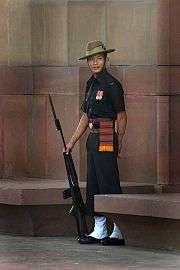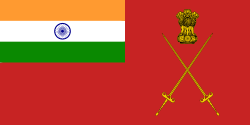Assam Regiment
| Assam Regiment | |
|---|---|
|
Regimental Insignia of the Assam Regiment | |
| Active | 15 June 1941 - Present |
| Country |
|
| Branch | Army |
| Type | Line infantry |
| Role | Light role |
| Size | 22 battalions |
| Regimental Centre | Happy Valley, Shillong, Meghalaya, India |
| Nickname(s) | The Rhinos |
| Motto(s) | Asam Vikram (Unique Valour) |
| War Cry | Rhino Charge[1] |
| March | Badlu Ram Ka Badan |
| Mascot(s) | Uni-horned rhinoceros of Assam |
| Engagements |
1945 (Burma Front) 1971 (Chaamb Sector) |
| Decorations | 1 Ashoka Chakra, 2 Maha Vir Chakra, 3 Kirti Chakra, 5 Vir Chakras, 14 Shaurya Chakras, 2 Padma Shris, 5 Ati Vishisht Seva Medals, 1 Yudh Seva Medal, 51Sena Medals and 8 Vishisht Seva Medals |
| Commanders | |
| Current commander | Lt Gen B S Negi |
| Notable commanders | Brig 'Papa' Pandey Padmabhushan, Brig. Thenphunga Sailo |
| Insignia | |
| Colours | Black and red (golden stripe added to the flag on the occasion of golden Jubilee) |
The Assam Regiment is an infantry regiment of the Indian Army. The regiment consists of 22 battalions: 15 regular battalions, 3 Rashtriya Rifles battalions, 3 Territorial Army infantry battalions and 1 battalion of Arunachal Scouts. It recruits exclusively from all the Seven Sister States of northeast India.
History

The regiment was raised on 15 June 1941 in Shillong by Lt. Col. Ross Howman to meet the claim of the then undivided state of Assam for its own fighting unit and to counter the threat of the Japanese invasion of India. The area of Elephant Falls in Shillong was chosen to raise the first battalion and it was there, under British instructors, that the first troops were trained. The initial draft of the regiment was drawn from undivided Assam, and consisted of the doughty Ahoms who had proved their martial prowess by defeating the Mughals at the Battle of Saraighat and the hardy, tough and cheerful Nagas, Mizos, Kukis, Garos, Meiteis and other tribals. Later, the Adis, Nishis, Monpas, other tribes of Arunachal Pradesh, domiciled Gorkhas and Sikkimese were also drafted into the regiment and, today, the regiment can boast of being composed of troops of diverse customs, cultures, languages, traditions and ethos belonging to the seven states of the northeast and Sikkim.
Within six months of its raising, the regiment was ordered to move to Digboi to defend the oil fields. In early 1942, it moved to Ledo and was involved in reconnoitering the alignment for the famous Stilwell Road. In 1944, when the invasion of India by Japan was imminent, the regiment was moved to Jessami and Kharasom to delay the advance of the Japanese 31st Division. The young regiment soon proved its capabilities within three years of its raising, at the consecutive battles of Jessami, the epic defence of Kohima and the capture of Aradura, all of which were awarded as battle honours (now known as pre-independence battle honours) to the regiment. The regiment earned high praise for its combat skills in World War II. In its very first operation, the regiment won 71 gallantry awards. In addition, the regiment won six battle honours including Jessami, Kohima, Aradura, Toungoo, Kyaukmyaung bridge-head and Mawlaik. It was also awarded the theatre honour Burma: 1942-45. Seldom has a regiment won so many gallantry awards, battle honours and theatre awards in a single campaign.
Two battalions were part of the Indian Peace Keeping Forces in Sri Lanka in 1988 and a battalion served in Cambodia in 1993 as part of the United Nations Transitional Authority in Cambodia. Three Territorial Army (TA) battalions and three Rashtriya Rifles (RR) battalions are affiliated with the regiment. The unique cultural and tribal character of the regiment makes for a fine combination of cheerful, tough and willing soldiers who excel in operations in mountainous and jungle terrain. The regimental colours are black and gold (state colours of undivided Assam) and scarlet (the colour of the infantry). Badges are silver with black backings. The side arm is the 'Dah'. The regimental language is Hindi. When spoken in the regiment, it is a quaint and unique mixture of Hindi generously sprinkled with words from all the northeastern languages and sounds cryptic to the uninitiated.
The regiment, from a small group of three battalions at the time of independence, has now become a 22-battalion strong force with 15 regular battalions, three Rashtriya Rifles battalions, three Territorial Army battalions and 1 battalion of Arunachal Scouts. Since independence, battalions of the regiment have participated in the Sino-Indian War of 1962 and all the conflicts with Pakistan. The regiment was awarded a battle honour for its tenacious defence at Chaamb in the Indo-Pakistani War of 1971. Two of its battalions, 4 Assam and 7 Assam, have had the privilege of being part of the Indian Peace Keeping Force (IPKF) in Sri Lanka and 1 Assam, 15 Assam and 10 Assam have the unique distinction of being part of the UN Peace Keeping Force in Cambodia (UNTAC), Lebanon (UNIFIL) and the Democratic Republic of the Congo (MONUSCO) respectively.
Insignia and Greeting
The regiment's emblem is the rhino, which is worn on the berets and belts that the soldiers (the self-named "Rhinos") wear. Rhinos in India are commonly found in the state of Assam. The regimental salutation of "tagra raho" ("stay strong/fit") is unique in the Indian Army. This unique greeting was introduced by the regiment's commanding officer during the 1960s, the late Maj. Gen. S.C. Barbora. He used to inquire about the morale of his soldiers by asking them "tagra ho?" ("are you strong/fit?"). Invariably, the answer used to be "tagra hai saheb" (I am strong/fit, sir). This greeting became popular in a very short period of time.
Post-Independence
Battle Honours
- Chaamb 1971
.jpg)
Honours & Awards
- 1 Ashoka Chakra - 2016 Havaldar Hangpan Dada
- 2 Maha Vir Chakra,
- 3 Kirti Chakra,
- 5 Vir Chakras,
- 1 Ashoka Chakra (Class III)(now Shaurya Chakra),
- 14 Shaurya Chakras,
- 2 Padma Shris,
- 5 Ati Vishisht Seva Medals,
- 1 Yudh Seva Medal,
- 51 Sena Medals and
- 9 Vishisht Seva Medals.
Regimental Battalions
- 1st Battalion - Always First
- 2nd Battalion - Second to None
- 3rd Battalion - Phantom Third
- 4th Battalion - Formidable Fourth
- 5th Battalion - Fighting Fifth
- 6th Battalion - Sabre Sixth
- 7th Battalion - Striking Seventh
- 8th Battalion - Head Hunters
- 9th Battalion - Nimble Ninth
- 10th Battalion - Thundering Tenth
- 12th Battalion - Daring Dozen
- 14th Battalion - Ferocious Fourteenth
- 15th Battalion - One Five
- 16th Battalion - Soaring Sixteen
- 17th Battalion - Saggital Ek Saat
- 119 Infantry Battalion (TA)
- 165 Infantry Battalion (TA) - Manipur Terriers
- 166 Infantry Battalion (TA) - Tezpur Terriers
- 134 Infantry Battalion (TA) - Eastern Planters
- 135 Infantry Battalion (TA) - Green Rhinos
- 35 Rashtriya Rifles
- 42 Rashtriya Rifles
- 59 Rashtriya Rifles
- 1 Arunachal Scouts
- 2 Arunachal Scouts
42 Rashtriya Rifles, formed specially to combat insurgency and terrorism, came into existence at a simple inaugural ceremony at the Assam Regimental Centre at Happy Valley in Shillong. Major General I.J.S Bora, GOC 101 Area, unfurled the Rashtriya Rifles (RR) flag heralding its formal birth. While four RR battalions had already been raised in the recent past, the 41st RR battalion (Maratha Light Infantry) was simultaneously raised in Karnataka's Belgaum. Maj. Gen. Bora said that as Meghalaya was relatively peaceful, there was no contemplation of deployment of armed forces at present. The force, raised to relieve the Army of counter insurgency operations, proved its mettle both in Jammu and Kashmir and other parts of the northeast.
The 3rd battalion of the regiment, 3 Assam (Phantom Third), recently celebrated its Diamond Jubilee. 6 Assam (Sabre Sixth) has performed ceremonial duties at Rashtrapati Bhavan and was selected for its outstanding work in counter terrorist operations. 14 Assam (Ferocious Fourteenth) won the Division and Command Football Championships and had fielded four players for the Army Reds & Greens. It had also won the first position in the Division Cambrian Patrol Championship 2009-10 & will be fielding its patrol in the Command Championships later in the year. 10 Assam (Thundering Tenth) won the division firing and sniper competition for the year 2011-2012. The contingent of the Assam Regiment was judged "Best Marching Contingent" thrice in the Republic Day celebrations held at Delhi in 1995, 2004 and 2016. The team of the Assam Regimental Centre won the 'Army Young Blood Firing Championship' in 2005 and stood second in 2006.
Uniform
The regiment wears Hat Terai similar to the one worn by the Gorkhas.
See also
References
- ↑ Raghavan, V. R. (1997-05-01). Infantry in India. Vikas Pub. House.
